Is your fickle feline just being a cat—or could it have cat depression? Here's how to tell.

Cat Depression: 11 Subtle Signs Your Cat Is Depressed


Swishing and twitching its tail
An upset cat has a major tell: a wagging tail. A happy kitty’s tail moves like a soft feather duster, but a sad or depressed cat may issue quick, hard strikes with its tail, says Danielle Bernal, DVM, a veterinarian with Wellness Natural Pet Food. Do a little investigating to find the source of their discomfort. “Cats are creatures of habit and do not like change, so start by addressing any recent changes,” Dr. Bernal advises.
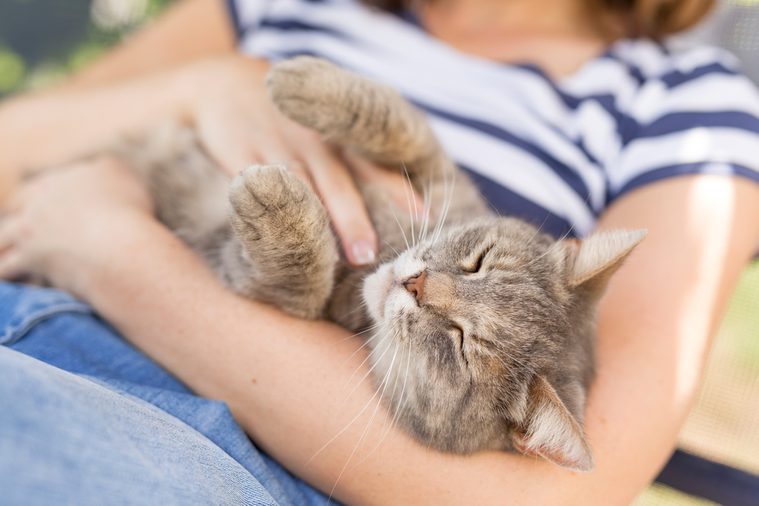
Suddenly becoming needy
Cats are known for being aloof, independent and moody, but in reality every animal has its own personality. Some cats are cranky, others are cuddly and still others like their humans to know who’s boss (the cat). If that changes, it’s cause for concern and may indicate feline depression, Dr. Bernal says.
“Many cat owners talk about how their cat curls up in their lap, smooches them in the morning and is the perfect companion,” she says. “Should this suddenly change, then don’t put it down to the fact she is just being a cat. It may be the first sign that she’s depressed.”

Swiping and scratching at your hand
Ah, the ol’ scratch-n-swipe, used by cats everywhere to show their displeasure with what’s happening. “When your feline friend resorts to the claws coming out and a quick swipe in frustration, you will know its mood is going down,” Dr. Bernal says.
It doesn’t mean your cat is innately cranky or chronically depressed, but it indicates your little friend is having a tough moment. Handle it like you would a sad child. “Nothing makes a cat calm down more than time with you,” she says. And don’t automatically entertain the idea of cat declawing, which is considered cruel and heavily discouraged by the ASPCA and the American Veterinary Medical Association (AVMA).
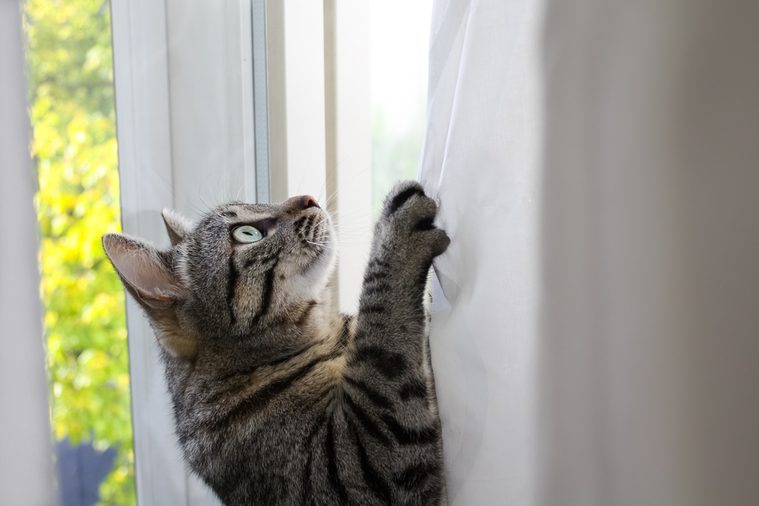
Climbing the walls
Unlike their human counterparts, cats literally go off the wall (and on) when they’re upset. This bad behavior, particularly when they have been properly trained to follow your house rules, can be one of the signs of a depressed cat. Their bad mood might stem from boredom, so make sure you’re providing plenty of stimulation for a depressed cat (or any cat, for that matter), Dr. Bernal advises.
“Make sure your home looks like a cat lives there—cat toys, climbing trees, cozy beds and scratching posts,” she says. “It lets the cat have its own space and feel like part of the household, and having its things to snooze in or play with will do just that.”
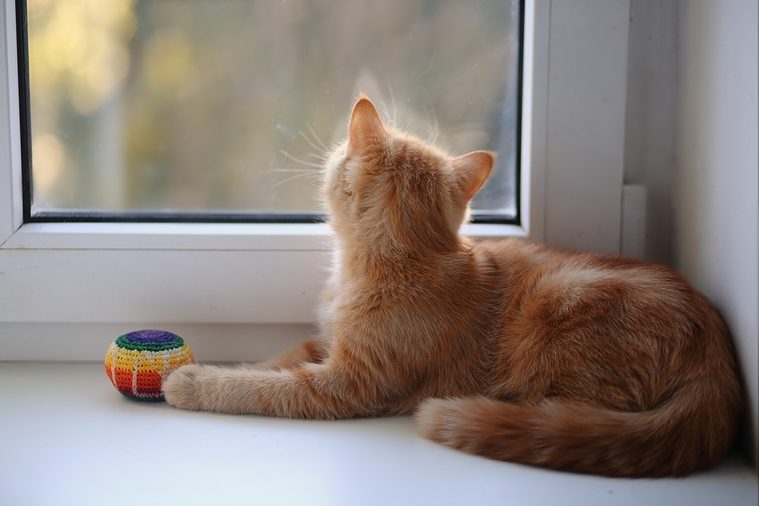
Pining away at the window
When you’re gone, your cat misses you, plain and simple—and that can turn into depression if you’re gone a lot. It is a common misconception that cats are indifferent to humans; in reality, they want to bond with their owners and be included as a member of the family, says Brian Ogle, PhD, who holds a doctorate degree in education, specializing in anthrozoology. Case in point: Your cat may rub against you as a sign of affection or a way to say “mine.”
Many times, humans do not interact enough with their cats because of this misconception, Ogle says. You can change that (at least in your house). Engage in active play on a regular basis to solidify the bond between human and cat, and to help make both of you feel warm and fuzzy inside.

Pooping in strange places
If your kitty is defecating in places other than its litter box, it can be a sign of an underlying medical issue, a situational problem or cat depression. It’s vitally important that you react in a positive way (even if that’s the last thing you feel when you step on a fresh pile of cat poop), Ogle says. “Because they are solitary animals, they lack the cognitive capability to interpret subtle social cues or to connect negative punishment to their specific action,” he says. Instead, use positive reinforcement to help a depressed cat and make sure its litter box is clean and easily accessible.

Ignoring loved ones
Unlike sleeping too much, avoiding people isn’t necessarily a sign of cat depression. But turning away from you or ignoring you can be, notes the Baker Ranch Animal Hospital in Lake Forest, California. “One of the more noticeable signs of depression for pet owners is perhaps social withdrawal,” the site writes. “The bottom line is that if your pet is avoiding interaction, even with their favorite people or other pets, it may indicate a deeper emotional issue.” Don’t force interaction—a depressed cat will come around to new people when it’s good and ready.

Hissing and spitting
The stereotypical signs of a mad cat—hissing, spitting, arching the back, drawing the claws—aren’t so much signs of anger as they are a cat’s way of saying it’s generally upset. Faced with these behaviors, you might not jump to the question, “Does my cat have depression?” But you should at least consider it.
“To deal with this behavior, I ignore the cat until she gets used to me and can see I’m not a threat,” Kavanaugh says. “I leave her alone in her sleeping area, and after a bit, she will usually warm up to me and refrain from hissing.”

Turning your furniture into a scratching post
If your cat isn’t normally a destroyer of furniture but has recently started shredding your sofa, it could be stressed out, which may look like cat depression to worried human owners, notes Betterpet. They explain that this is a way for cats to relieve pent-up stress. Consider using a cat pheromone diffuser or spray to calm down your pet naturally. You can also take some steps to prevent cats from scratching furniture in the future, such as having approved scratchers nearby, curbing boredom and using pet-safe deterrents.
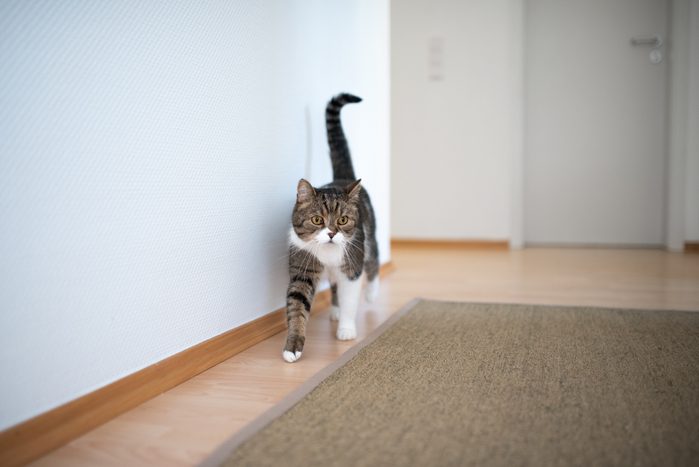
Spraying your walls
Cats are very territorial and see your house and yard as their kingdom, so when someone “invades” their space, it can tank their mood, says animal communication expert Karen Miura. “Things like claw marks on furniture and urine spray on walls are simply fresh boundary lines your cat sets when it feels like its territory was threatened by an intruder,” she explains. “The intruder could be anything from a mouse in the cupboard to a change in routine.”
If removing the intrusion isn’t an option (you aren’t about to kick out your new baby, for instance), try to keep as many things constant for your depressed cat as possible, as change is something cats really hate.

“Crying” for no apparent reason
Your furry friend might not speak English, but cats do use vocalizations to express their feelings. The sounds of cat sadness might not be the blue mews you’d expect. Any excessive meowing can be a sign that a cat is lonely, stressed or needs attention for other health reasons. If your kitty seems down, leave more toys to keep it happy when you’re away, and give it extra cuddles when you can.
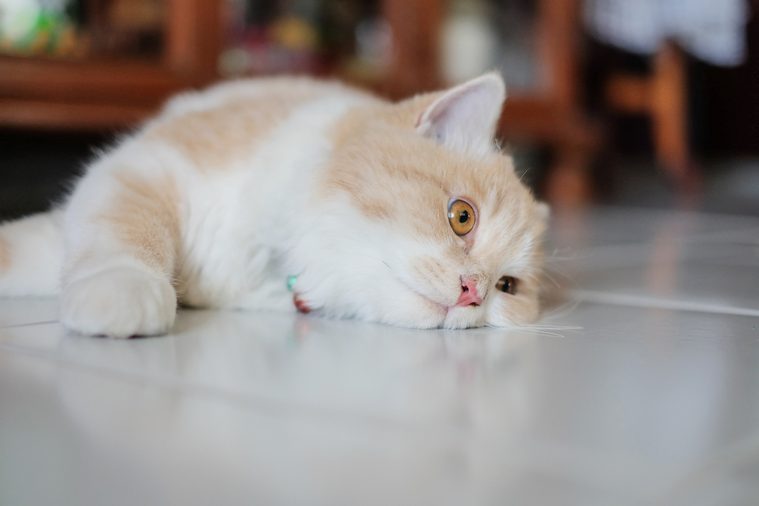
How to help a depressed cat
When it comes to kitties, the question isn’t “Can cats get depressed?” so much as “Is there anything I can do to help?” Thankfully, the answer is yes. Sad, angry, depressed or otherwise dysregulated cats need two things from you, says Kavanaugh: trust and unconditional love.
“Your cat needs to trust you to be the constant in its life. Everything starts from that base of trust,” she says. Here are five things she recommends you do to build trust and show your love:
- Provide nutritious food and clean water.
- Seek out regular, quality vet care—especially when your cat is showing signs of distress.
- Give it a safe, enclosed environment to sleep and live in.
- Create an enriching environment with lots of variety.
- Do not abandon them.
When it comes to showing love, most cats’ love language is physical touch. “Every cat is different, but you know yours best,” Kavanaugh says. Most appreciate scratches on the chin and ears, but do what you know your cat enjoys. The best part is that they’ll give you back all that love—and more.
About the experts
|
Why trust us
At Reader’s Digest, we’re committed to producing high-quality content by writers with expertise and experience in their field in consultation with relevant, qualified experts. We rely on reputable primary sources, including government and professional organizations and academic institutions as well as our writers’ personal experiences where appropriate. We verify all facts and data, back them with credible sourcing and revisit them over time to ensure they remain accurate and up to date. Read more about our team, our contributors and our editorial policies.
Sources:
- ASPCA: “Destructive Scratching”
- AVMA: “Declaw or Not?“
- Baker Ranch Animal Hospital: “Pet Mental Health: Recognizing Signs of Anxiety and Depression in Pets”
- Betterpet: “Cat depression: Causes, signs, and treatment”
- Dawn Kavanaugh, cat behaviorist and the CEO of All About Animals Rescue and Catsultations
- Danielle Bernal, DVM, veterinarian with more than a decade of experience in veterinary medicine, specializing in animal nutrition
- Brian Ogle, PhD, director of conservation learning and audience impact at the Brevard Zoo in Melbourne, Florida
- Karen Miura, animal communication expert with Whispers for Animals



















